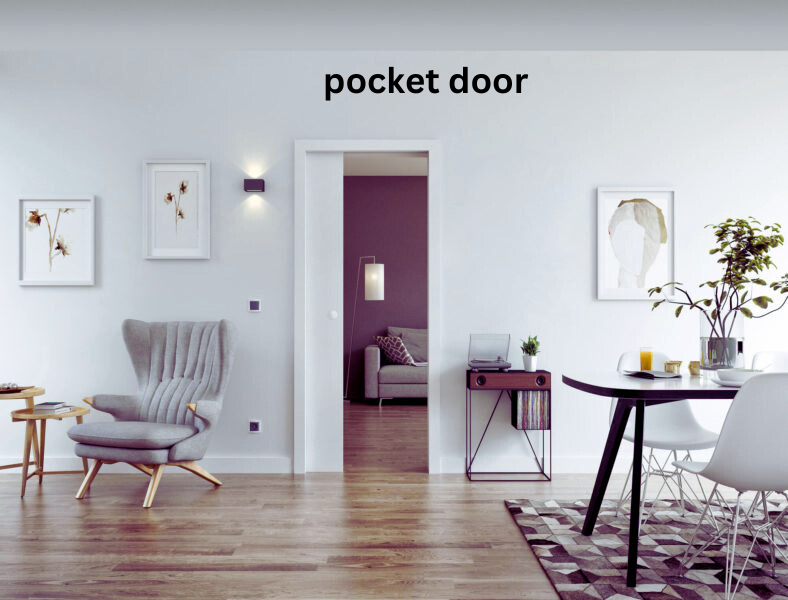What is a pocket door?
A sliding door that blends into a wall niche is called a pocket door. This basically solves the primary problem with hinged doors, which is that they take up space on the floor when they open into a corridor or room. There are single and double pocket door formats available; double pocket doors necessitate a wall cavity on either side.
A Brief Overview of Pocket Doors’ History:
You may reasonably assume that pocket doors are a relatively new invention if you didn’t know about them. Actually, pocket doors have been there since the 1950s; the only thing that has changed is that, although they were originally exclusively found in affluent homes, anyone may now install one.
The larger issue was that these doors were heavy, unwieldy, noisy, and even prone to falling off the tracks. After multiple design iterations and a shift to the present day, modern pocket doors are streamlined, sleek, attractive, and require less floor space.
What Makes Pocket Doors the Best Option?
The main advantages of pocket doors over regular doors are their adaptability, practicality, and seclusion. However, there are more justifications for installing a pocket door; consider the following:
- maximizes available area in tiny spaces, in contrast to hinged doors
- The majority of pocket doors are elegant and stylish.
- Blend in with any space while ensuring more security and privacy.
- Simple to employ.
- When necessary, rooms can be connected and divided.
- Crisp and clear lines are complemented by minimalist design.
Different Kinds of Pocket Doors:

It’s time to consider the type of pocket door after you’ve decided on its placement and style. To assist you, we have enumerated the most popular choices below:
- just one pocket door
- Two-panel pocket door
- Double glass doors or right
- personalized doors
- Doors for cavities
- Smartrobe components
Despite the fact that each of these choices has advantages and disadvantages, you can generally count on the following benefits:
- Soundproofing
- Sturdiness
- Not flammable
- Safety
Advantages of a Pocket Door:
1. You can save a lot of floor and wall space by using pocket doors. They come in particularly useful in compact areas where a typical door would take up precious space, including small bedrooms and Jack-and-Jill bathrooms.
Get additional space-saving ideas for a master bathroom, including how to save space with a pocket door.
2. Compared to standard swing doors, pocket doors have a cleaner visual appearance and more usable wall space when they are open. When the door is open, you can still view photographs, or a mirror hung next to the pocket door frame. Additionally, open pocket doors vanish in modern dwellings, preserving a clean aesthetic.
Drawbacks of a Pocket Door:
1. Because pocket doors are track-based, repairs may be more challenging if something goes wrong with the hardware. Invest in and install the best gear you can afford to avoid issues.
This is how to adjust a noisy or sticky pocket door.
2. Make sure you are happy with how the door will open and close once installed by testing the hardware before deciding to install a pocket door. Pocket doors might be more difficult to operate than standard swing doors for people with particular physical impairments.
To find out how to take out and replace a pocket door, watch this video.
You can accomplish it! This is how to construct a tiny bathroom.
FAQS:
What distinguishes a sliding door from a pocket door?
Finding a wall recess is an easy way to distinguish between the two, even though their comparable mechanisms may cause confusion. A pocket door takes up very little floor area and disappears entirely into a wall recess next to it. However, a sliding door moves parallel to the wall rather than gliding into it.
Which type of door works best with a pocket door?
Any regular door may be converted into a pocket door as long as you know the dimensions and approximate thickness of the door aperture. Make sure the door is pre-drilled as well, as the measurements may be for standard locksets and You will be unable to use such a unit with door hinges.
Are pocket doors lockable?
Pocket doors have a sliding mechanism, but you may still lock them to secure your house. A lock can be installed on one or both of the door’s ends, though some customers choose the much more conventional lock and key arrangement. A pocket door lock is often square or round in shape.
What is the size of a pocket door?
Pocket doors typically have dimensions of 30-36 inches in width and 80 inches in height. However, the height can differ; we’ve seen single-door variants with widths of 24 to 48 inches and heights of 80 to 120 inches. This implies you can alter the door opening’s dimensions to make it smaller or more expansive.
for more visit our Homepage.

